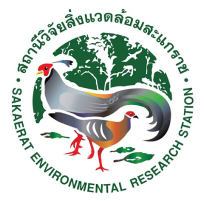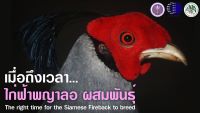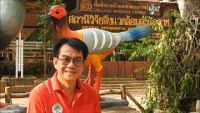Keywords :
Small Mammal; Population Dynamic; Ectoparasite
บทคัดย่อ :
Small mammal communities were studied over 12 months since January 2007- December 2007 in three dry tropical habitats; dry dipterocarp (DD), ecotone (ECO) and dry evergreen (DE) forest, in Sakaerat Environmental Research Station, North-eastern Thailand. Mark-recapture grids were used to catch animals, and data were collected on age structure, population dynamics, diversity indices, biomass and minimum home-range size. The year was divided into four seasons; early rainy (May-July), late rainy (August-October), winter (November-January) and summer (February-April). From a total of 3,528 trap nights, there were 1,047 captures of 371 individuals (29.68% capture rate), comprising six species of rodent and one species each of Scandentia, Lagomorpha and Carnivora. The four most common species caught at all sites were Maxomys surifer, Tupaia glis, Rattus rattus and Leopoldamys sabanus, with M. surifer being the most frequently caught species in all forest types. Population age structure, density and biomass, but not community structure or sex ratios, varied by forest type and season in these species. Minimum home range size was largest in the winter and summer in all forest types in all four species. M. surifer had the highest population densities in all forest types in all seasons. Density estimates for M. surifer and L. sabanus in all habitat types, and for T. glis and R. rattus in DE forest, correlated positively with a range of ecological factors including tree species, tree density, basal area, average diameter at breast height, average height, canopy cover, and ground cover. In the ECO and DD forests, the density estimates for T. glis and R. rattus were negatively correlated with these environmental factors. A concurrent study of ectoparasites and blood parasites was undertaken on these four species. The most prevalent ectoparasites found were a mite (Lealaps echidinus), a tick (Ixodes sp.), a flea (Xenopsylla cheopsis) and a pseudoscorpion (Chelifer cancroides), with L. echidinus and Anaplasma sp. being the two most frequently recorded. Blood parasites detected were identified as Microfilaria sp., Trypanosoma sp., Anaplasma sp. and Grahamella sp.. M. surifer had the highest numbers of ectoparasites and blood parasites. The relationship between ectoparasites and blood parasites differed to the typical pattern reported in the literature, with the same ectoparasites and blood parasites occurring across a range of host species, and the relationship between ectoparasites and blood parasites showing different patterns across hosts. In M. surifer, the incidence of Trypanosoma sp. was different patterns across hosts. In M. surifer, the incidence of Trypanosoma sp. was positively correlated with age. Blood serum biochemistry varied significantly across habitat type, season, sex and age in all four host species. The incidence of blood parasites did not correlate with total serum biochemistry values, strongly suggesting that the four host species studied here may be acting as reservoirs for these parasites.
เอกสารอ้างอิง :
Pinmongkholgul, S. (2008). Population dynamics and health status of small mammals at Sakaerat environmental research station, Nakhon Ratchasima (Doctoral dissertation, School of Biologly, Institute of Science Suranaree University of Technology).



